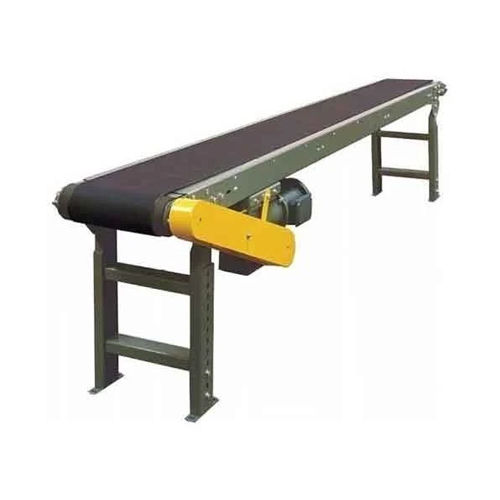Belt Conveyor Price & Specifications
Warranty Yes
Voltage 220-440 Volt (v)
Vertical Conveyor No
Usage & Applications Material handling in manufacturing, warehouses, logistics, and distribution centers
Type Belt Conveyor
Thickness Standard: 2-10 mm depending on application
Surface Finish Powder coated / Painted
Structure Robust metal frame
Speed Variable, typically 0.5 - 2 m/s
Size Different Available
Roller Conveyor No
Resistant Feature Corrosion Resistant
Product Type Belt Conveyor
Power Source Electric
Power From 1 HP upwards (as per conveyor size)
Pneumatic Conveyor No
Material Metal
Load Capacity Customizable as per requirement
Features Durable construction, smooth operation, easy maintenance
Belt Type PVC/PU/Rubber (custom options available)
Belt Conveyor Yes
Supply Ability 20 Per Month
Sample Available Yes
Main Domestic Market ], [
Delivery Time 10 Days
About Belt Conveyor Detail
A conveyor is a mechanical system used to transport goods, products, and materials from one place to another.Key Features1. Efficient Transportation: Conveyors enable efficient transportation of goods and materials.2. Reduced Labor Costs: Conveyors automate material handling, reducing labor costs.3. Increased Productivity: Conveyors enable continuous operation, increasing productivity.4. Customizable: Conveyors can be customized to fit specific application requirements.Types1. Belt Conveyor: Uses a belt to transport goods and materials.2. Chain Conveyor: Uses chains to transport goods and materials.3. Roller Conveyor: Uses rollers to transport goods and materials.4. Slat Conveyor: Uses slats to transport goods and materials.5. Overhead Conveyor: Suspended from the ceiling to transport goods and materials.Applications1. Manufacturing: Conveyors are used in manufacturing applications such as assembly, packaging, and material handling.2. Logistics: Conveyors are used in logistics applications such as warehousing, distribution, and transportation.3. Agriculture: Conveyors are used in agricultural applications such as harvesting, processing, and packaging.4. Mining: Conveyors are used in mining applications such as extraction, processing, and transportation.Benefits1. Increased Efficiency: Conveyors automate material handling, reducing labor costs and increasing productivity.2. Improved Safety: Conveyors reduce the risk of injury from manual material handling.3. Reduced Maintenance: Conveyors require minimal maintenance and upkeep.4. Cost Savings: Conveyors can help reduce energy consumption and increase productivity.Flexible Sizing for Every ApplicationCustomizable widths from 300 mm to 1000 mm and lengths up to 20 meters ensure adaptation to diverse material handling needs. The option for tailored dimensions allows integration into existing workflow, optimizing space utilization for manufacturing, warehousing, and logistics environments.
Efficient and Quiet MotorizationEquipped with an induction motor and gearbox, the belt conveyor guarantees low-noise operation even in demanding settings. Variable speed control, adjustable from 0.5 to 2 m/s, supports precise handling of goods while maintaining a comfortable working environment.
Durable Construction and Easy MaintenanceManufactured from metal with corrosion-resistant features and a robust frame, the conveyor is built to withstand intensive use. The powder-coated or painted surface finish extends lifespan, while accessible design enables simple installation and routine maintenance.
FAQs of Belt Conveyor:
Q: How do I select the appropriate width and length for my belt conveyor system?
A: To choose the suitable width and length, consider the dimensions and volume of materials you need to transport. The conveyor is available in standard widths (300 mm, 600 mm, 800 mm, 1000 mm) or can be custom-built. Length can also be tailored up to 20 meters. Consultation with the supplier helps ensure optimal configuration for your application.
Q: What is the process for installation and assembly of the belt conveyor?
A: The belt conveyor is designed for floor mounting and straightforward assembly. Components are delivered ready for onsite installation; adjustable supports allow height customization. Basic electrical connections are required for motor operation, and the supplier often provides guidance or onsite installation support.
Q: Where is this belt conveyor typically used?
A: This belt conveyor finds applications in manufacturing facilities, warehouses, logistics centers, and distribution hubs. Its design suits diverse material handling needs, facilitating the smooth movement of goods across different operational environments.
Q: What are the benefits of the adjustable supports and variable speed operation?
A: Adjustable supports make it easy to set the conveyor at the required height for your workflow, enhancing ergonomics and efficiency. Variable speed operation (0.5 - 2 m/s) allows for precise control over material movement, reducing the risk of damage to sensitive items and optimizing throughput.
Q: Is the belt type customizable for specific materials or operational environments?
A: Yes, you can choose from PVC, PU, or rubber belts, depending on your material handling requirements. These options accommodate different durability, grip, or surface finish needs, ensuring compatibility with a wide range of products and operating conditions.
Q: What load capacities can the belt conveyor support?
A: Load capacity is customizable and determined by your specific requirements. The robust metal frame and adjustable supports help accommodate varying weights, making it suitable for everything from lightweight packages to heavier industrial components.

